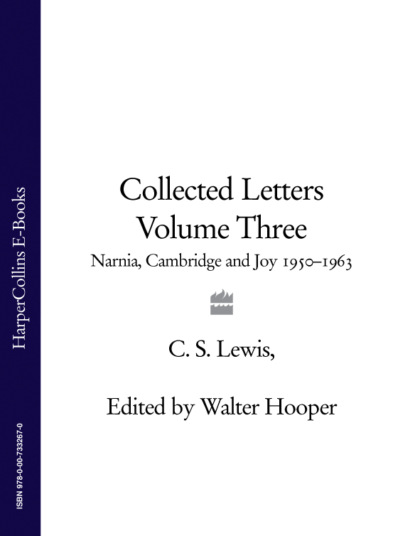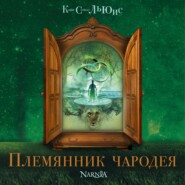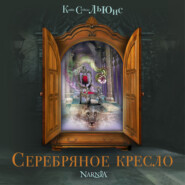По всем вопросам обращайтесь на: info@litportal.ru
(©) 2003-2025.
✖
Collected Letters Volume Three: Narnia, Cambridge and Joy 1950–1963
Настройки чтения
Размер шрифта
Высота строк
Поля
94 (#ulink_04ed593e-3552-5127-aa10-4f7890613e83) See Cecil Harwood in the Biographical Appendix to CL I (pp. 998-1000).
Harwood, one of Lewis’s oldest friends, was an anthroposophist and a teacher at Michael Hall School, Kidbrooke, Forest Row, East Sussex.
95 (#ulink_9897a736-28fb-55be-8271-f1b38a8d4752) Virgil, Aeneid, II, 61: ‘prepared for either thing’.
96 (#ulink_5cc1fbc7-f8bd-5b49-93b5-cd85b7b19a42) In SB], ch. 13, p. 155, Harwood is described as ‘a pillar of Michael Hall’.
97 (#ulink_5cc1fbc7-f8bd-5b49-93b5-cd85b7b19a42) The Bellman was the captain of the ship in Lewis Carroll’s The Hunting of the Snark (1876). In Fit the Second, stanzas 5-8, the Bellman persuades his crew that a blank sheet of paper makes an ideal chart of the open sea. ‘This was charming, no doubt: but they shortly found out/That the Captain they trusted so well/Had only one notion for crossing the ocean,/And that was to tingle his bell./…And the Bellman, perplexed and distressed,/Said he had hoped, at least, when the wind blew due East,/That the ship would not travel due West!’
98 (#ulink_5cc1fbc7-f8bd-5b49-93b5-cd85b7b19a42) Harwood had written to tell Lewis that his wife, Daphne, was dying of cancer.
99 (#ulink_92c539d6-2da7-57a3-b4b8-140432d4289e) Lewis had published a poem, ‘As One Oldster to Another’ under the pseudonym ‘N.W.’ in Punch, CCXVLII (15 March 1950), p. 295. Mr Dixey wrote to compliment him on his use of Alcaics, a four-line stanza using a predominantly dactylic metre named after the Greek poet, Alcaeus. A slightly revised version of the poem appears in Poems (1974) and CP.
100 (#ulink_94499a76-05f2-566f-974e-fbbecd7cc9ce) Ernest H. Shepard (1879-1976), a cartoonist for Punch, illustrated ‘As One Oldster to Another’ and other of Lewis’s poems. Shepard also illustrated all A. A. Milne’s Winnie the Pooh books.
101 (#ulink_3e4420d6-3518-5a50-bfb8-d40d5a8aea22) In 1942 Lewis had Owen Barfield set up a charitable trust into which Lewis directed all his royalties. It was named ‘Agapony’ ‘or ‘Agapargyry’ or ‘The Agapargyrometer’ = love + money. The money was available for whoever might be in need, with preference given to widows and orphans. For details see CL II, p. 483.
102 (#ulink_3e4420d6-3518-5a50-bfb8-d40d5a8aea22) While protecting Lewis’s confidentiality, Barfield devoted a chapter to the Agapony in his book This Ever Diverse Pair (1950).
103 (#ulink_38375ea2-ef6a-535c-8b5e-e59942da94c5) Harwood had written to say that he had received some money from the Agapony fund.
104 (#ulink_fe83c78e-c39f-5f8c-8e9c-0d1249f300bb) See Stella Aldwinckle, founder of the Socratic Club, in the Biographical Appendix.
105 (#ulink_1dfa4e01-9b0a-561c-a33a-1b699e090ec3) As president of the Oxford University Socratic Club, Lewis was suggesting in his letter to Aldwinckle a list of people she might ask to speak at the club, along with possible topics.
106 (#ulink_43b92d14-0884-54b7-89de-d8506edaf40a) Gilbert Ryle (1900-76), philosopher, was Waynflete Professor of Metaphysical Philosophy and Fellow of Magdalen College, Oxford, 1945-68.
107 (#ulink_43b92d14-0884-54b7-89de-d8506edaf40a) Henry Habberley Price (1899-1984), philosopher, was educated at Winchester College and New College, Oxford, where he took a First in Classics in 1921. In 1924 he was elected a Fellow and lecturer in Philosophy at Trinity College, Oxford, where he remained until 1935. In that year he was elected Wykeham Professor of Logic and moved to New College where he remained until his retirement in 1959. He was a frequent speaker at the Socratic Club. See his biography in the Oxford DNB.
108 (#ulink_781e6b06-5f33-5129-8f40-a59e45ebd2b3) i.e., an admirer of Jean-Paul Sartre.
109 (#ulink_781e6b06-5f33-5129-8f40-a59e45ebd2b3) Francis Joseph ‘Frank’ Sheed (1897-1981), publisher and author, was born in Sydney, Australia, and read law at Sydney University, taking his BA in 1917. In 1920 he went to London where he came across the recently formed Catholic Evidence Guild, devoted to out-of-doors speaking to explain the teaching of the Roman Catholic Church. He was bowled over by the excitement of the Guild’s task, and he joined. There he met Mary ‘Maisie’ Josephine Ward (1889-1975), and they were married in 1926. That same year Frank and Maisie founded a publishing firm, Sheed and Ward. In 1933 they opened an office in New York, through which Sheed and Ward became the most influential Catholic publisher in the English-speaking world. Maisie died on 28 January 1975 and Frank on 20 November 1981.
110 (#ulink_781e6b06-5f33-5129-8f40-a59e45ebd2b3) Christopher Dawson (1889-1970), cultural historian, was born at Hay, Brecknockshire, on 12 October 1889 and educated at Winchester College and Trinity College, Oxford, taking his degree in 1911. He had sufficient means to be able to follow his own highly original path of historical research and reflection. His first book, The Age of the Gods (1928), was the result of fourteeen years of research. His second, Progress and Religion (1929), articulated the major theme of his subsequent writings, that religion is the dynamic of all social culture. The Making of Europe (1932) discussed a specific case of this, showing that the ‘dark ages’ were in fact the most creative period in the culture of the Western world. Dawson developed the topic further in his Gifford Lectures for Edinburgh University, Religion and Culture (1948), about which Lewis wrote to him on 27 September 1948 (see Supplement). Dawson became a Roman Catholic shortly after going down from Oxford and was an influential member of the group of writers which formed around the Catholic publishing house of Sheed and Ward. Dawson’s achievements were mainly overlooked by the academic world. He was eventually offered a chair in the United States at Harvard where he was Professor of Roman Catholic Studies, 1958-62. He died on 25 May 1970.
111 (#ulink_05fe74e6-7f25-5304-8494-dec0aa2d1f9d) Henry Fitzgerald Heard (1889-1971), science writer and philosopher, was educated at Gonville and Caius College, Cambridge, after which he lectured for Oxford University’s extra-mural studies programme, 1926-9. He took a strong interest in developments in the sciences and his The Ascent of Humanity (1929) marked his first foray into public acclaim. He served as a science and current affairs commentator for the BBC, 1930-4. In 1937 he moved to the United States, accompanied by Aldous Huxley, to accept the chair of Historical Anthropology at Duke University. His most famous book, The Five Ages of Man, was published in 1963. He died on 14 August 1971.
112 (#ulink_05fe74e6-7f25-5304-8494-dec0aa2d1f9d) Aldous Leonard Huxley (1894-1963), English novelist, won a scholarship to Balliol College, Oxford where in 1916 he took a First in English. His first novel, Crome Yellow (1921), was followed by others satirizing contemporary society through characters who flout convention. While in Italy he wrote Brave New World (1932). His move to California in 1937 coincided with a move away from his ‘philosophy of meaninglessness’ to something more transcendental and mystical. The books that followed, such as Brave New World Revisited (1958), spelt out the temptations presented by life in the modern world with its materialist values and dangerous technological advances. Huxley died on the same day as John F. Kennedy and Lewis–22 November 1963.
113 (#ulink_05fe74e6-7f25-5304-8494-dec0aa2d1f9d) This was probably Fr John Philip Gleeson, who took a B. Litt. from Campion Hall in 1951.
114 (#ulink_ea88fb5c-5cdb-55da-be7b-efc920fee2b3) Gertrude Elizabeth Margaret Anscombe (1919-2001), philosopher, was born on 18 March 1919 at Glanmire, North Strand, Limerick. Her conversion to Catholicism as a teenager led to a lifelong interest in philosophy. She was educated at St Hugh’s College, Oxford, where she took a First in Greats in 1941. The following year she moved to Cambridge where, as a research student, she became the pupil of Ludwig Wittgenstein. In 1936 she returned to Oxford as a Research Fellow at Somerville College. She was a Fellow of Somerville, 1964-70, and Professor of Philosophy, Cambridge University, 1970-86. She died on 5 January 2001. On her debate with Lewis about Miracles: A Preliminary Study (London: Bles, 1947) see her biography in CG.
115 (#ulink_55bd263f-4f06-5dc4-b8d5-19db7f57aa6e) Colin Hardie, one of the Inklings, was Classical Tutor at Magdalen College, Oxford. See Colin and Christian Hardie in the Biographical Appendix.
116 (#ulink_5ac0800c-70de-52a0-9bb7-27f21c19b83b) New Testament.
117 (#ulink_5ac0800c-70de-52a0-9bb7-27f21c19b83b) The Rev. Dr Austin Farrer was Chaplain and Tutor of Trinity College, Oxford. See Austin and Katherine Farrer in the Biographical Appendix.
118 (#ulink_68b28af2-5ce4-53df-808e-1a88b110160b) Basil Mitchell (1917–), philosopher, was educated at the Queen’s College, Oxford, where he took a BA in 1939. He was Fellow and Tutor in Philosophy at Keble College, Oxford, 1947-67, and Nolloth Professor of Philosophy of the Christian Religion, Oxford University, 1968-84. An active member of the Socratic Club, he followed Lewis as its president in 1955.
119 (#ulink_2532ff4f-3fdd-5880-93a0-993b4ccbe867) Alfred Jules Ayer (1910-89), Wykeham Professor of Logic at Oxford, 1959-78, was a proponent of logical positivism, and the author of Language, Truth and Logic (1936).
120 (#ulink_00d106aa-3bfd-57c4-ba64-e8ff78b644b7) On 2 February 1948 Elizabeth Anscombe gave a paper to the Socratic Club on Lewis’s Miracles entitled ‘A Reply to Mr C. S. Lewis’s Argument that “Naturalism” is Self-Refuting’. It was published in the Socratic Digest, no. 4 (1948) and is reprinted in her Collected Philosophical Papers, Vol. II, Metaphysics and the Philosophy of Mind (1981). Anscombe’s argument concerned the nature of causation, one of its crucial points being that Lewis should have distinguished in chapter 3 of Miracles between ‘irrational causes’ and ‘non-rational causes’. Lewis accepted that he might have made his argument clearer and this he attempted to do by revising chapter 3 for the Fontana paperback of Miracles. See the letters to Jocelyn Gibb of 11 July and 8 August 1959.
121 (#ulink_c0dd6fcf-8aac-599a-8cf1-373e647843f1) Professor Dorothy Emmet (1904-2000), philosopher, Professor of Philosophy at the University of Manchester, 1946-66.
122 (#ulink_906a96f9-f484-57b3-b320-efd206376138) lili had become engaged to the writer Clement Freud, and their engagement was announced in The Timer. ‘Clement Raphael third son of Ernst and Lucie Freud of St Johns Wood London to June Beatrice second daughter of H. W. Flewett M.A. and Mrs Flewett of Gipsy Lane London SW15.’
123 (#ulink_6b1f581e-bbc5-5c45-a12c-b4d53cf7ca2f) This note was added later in Lewis’s hand, lili sent him a copy of the Wilton Diptych, the full title of which is Richard II Presented to the Virgin and Child by his Patron Saint John the Baptist and Saints Edward and Edmund. The diptych was painted between 1395 and 1399, and is in the National Gallery, London. It is called the Wilton Diptych because it came from Wilton House in Wiltshire, the seat of the Earls of Pembroke. Lewis treasured this gift all his life, and had it with him in Magdalene College, Cambridge, during his years there.
124 (#ulink_ce48582a-9fd7-55bc-94ed-fa8c9b62d770) Arthur’s cocker spaniel.
125 (#ulink_4698b384-06f3-5123-9a67-cf336b007f16) Mrs D. Jessup was writing from 66 Milton Road, Rye, New York.
126 (#ulink_c6bb93ab-2cfc-574d-b7b4-5821d440580d) A house-maid.
127 (#ulink_defb31e3-f045-55f7-bdaf-3659904e35f5) Virgil (70-19 BC), Aeneid. Lewis probably read the Aeneid more often than he did any other book.
128 (#ulink_e81e1ccc-c3aa-5a0f-8daa-29e93c8c84ef) Green and Hooper, C. S. Lewis: A Biography, ch. 11, p. 310.
129 (#ulink_a773a799-a900-56d7-8e63-60cfcf7183d2) Griffiths was planning to visit Oxford.
130 (#ulink_bcebc5fb-e970-5e0c-9a22-882ed9a13801) Mathews wrote to Lewis on 24 June 1950: ‘I’m in the midst of ARTHURIAN TORSO at the moment, but am having trouble with the pronunciation. How does one pronounce TALIESSIN and BROCELIANDE? Did you ever complete the idea for a children’s story you wrote me about?’ (Bodleian Library, MS. Facs. c. 47, fol. 191), Lewis, presumably, meant the second, not third, syllable of Brocelliande.
While Lewis was referring to the imminent publication of The Lion, The Witch and the Wardrobe, Mathews was probably remembering a comment in his letter of 17 September 1949: ‘A good idea for a (children’s) story…arrived this morning’ (CL II, p. 980), this being the second Narnian story, Prince Caspian.
131 (#ulink_fe348157-aa7e-5cc4-bb66-f8799de6a287) ‘Pray for us’.
132 (#ulink_d7c8ead8-f985-5bca-9c88-c91a472afedd) Mark 4:5-6: ‘There went out a sower to sow. And it came to pass, as he sowed, some fell by the wayside, and the fowls of the air came and devoured it up. And some fell on stony ground, where it had not much earth; and immediately it sprang up, because it had no depth of earth. But when the sun was up, it was scorched; and because it had no root, it withered away’
133 (#ulink_c0af3f10-e8a1-5b2b-a1c0-684212cf8b22) When in 1935 Oxford University Press conceived the idea of the mammoth Oxford History of English Literature (OHEL), Lewis was asked to contribute a volume covering the sixteenth century. He had been working on what was to be English Literature in the Sixteenth Century, Excluding Drama (1954) since 1936 and he was spending every available minute in the Bodleian Library trying to complete it. He called it his ‘O Hell!’ volume.
134 (#ulink_6aeeb4a2-9101-5d72-829d-b9b8b15fd636) Acts 2:1-9: ‘And when the day of Pentecost was fully come, they were all with one accord in one place. And suddenly there came a sound from heaven as of a rushing mighty wind, and it filled all the house where they were sitting…They were all filled with the Holy Ghost, and began to speak with other tongues, as the Spirit gave them utterance. And there were dwelling at Jerusalem Jews, devout men, out of every nation under heaven. Now when this was noised abroad, the multitude came together, and were confounded, because that every man heard them speak in his own language…Parthians, and Medes, and Elamites, and the dwellers in Mesopotamia, and in Judea, and Cappadocia, in Pontus, and Asia.’
135 (#ulink_3aff7cee-cdd0-5a56-bbaa-fd2bbb82241e) Ralph E. Hone was writing from 39 Leicester Square, London.
136 (#ulink_b2b14e64-da28-53f8-8b1b-de48acbafe16) See Chad Walsh in the Biographical Appendix to CL II, pp. 1078-81.
137 (#ulink_3070ce5c-9d00-528a-9c25-4de1f7fc3a2e) Daphne Harwood died on 14 July 1950.
138 (#ulink_f9c180b7-bda9-5b9c-8ea7-6f87b95859d0) Lewis was John Harwood’s tutor at Magdalen College, and John had just taken a fourth-class degree in Schools.
139 (#ulink_b77599df-8f6e-5760-8b2c-caef46fbdab8) See St Giovanni Calabria in the Biographical Appendix to CL II, pp. 1036-9. Don Giovanni Calabria was the founder of the Congregation of Poor Servants of Divine Providence in Verona. In 1947 he read The Screwtape Letters in Italian. Wishing to write to Lewis about his books and about Christian unity, but not understanding English, he began corresponding in Latin. Most of the correspondence between Lewis and Don Calabria was published as Letters: C. S. Lewis-Don Giovanni Calabria: A Study in Friendship, trans, and ed. Martin Moynihan (London: Collins, 1989). Unless otherwise stated, the letters were translated into English by Moynihan (see his biography in CL II, p. 615n). There is also an Italian edition of the correspondence, with some additional letters between Lewis, St Giovanni Calabria and Don Luigi Pedrollo, entitled Una Gioia Lnsolita: Lettere tra un prete cattolico e un laico anglicano, ed. Luciano Squizzato, trans. Patrizia Morelli (Milan: Jaca Book SpA, 1995). Those additional letters appear in the present volume.
140 (#ulink_d3f1141c-c233-5733-95b5-75262cf63010)Le Problème de la Souffrance, trans. Marguerite Faguer, with an introduction by Maurice Nédoncelle (Bruges: Desclées de Brouwer, 1950).
141 (#ulink_d3f1141c-c233-5733-95b5-75262cf63010) In Una Gioia Insolita Luciano Squizzato (p. 156, n. 92) notes that both Lodetti and Arnaboldi denied ever having received this volume, and that no copies can be found in St Giovanni Calabria’s private library. Calabria was at this time seriously ill; Fr Pedrollo, who answered this missive, was deeply concerned for his friend’s health, and may have simply been vague about the books; apparently, Lewis just sent one to him (see Lewis’s letter of 12 September 1950). For biographical information on Dr Romolo Lodetti see CLII, pp. 821-2. Fr Paolo Arnaboldi (1914-98) was the founder of FAC, a Catholic movement in part inspired by Calabria’s books Apostolica vivendi and Amare (see Squizzato, pp. 262-3); incidentally, these were the books Calabria sent to Lewis in the autumn of 1947 (see CL II, p. 807).

















